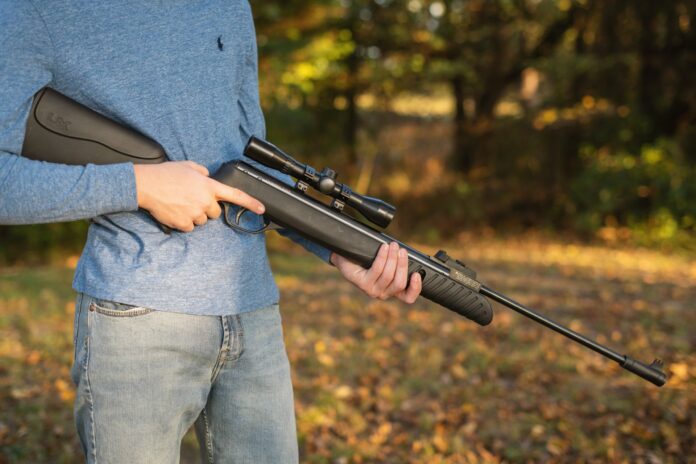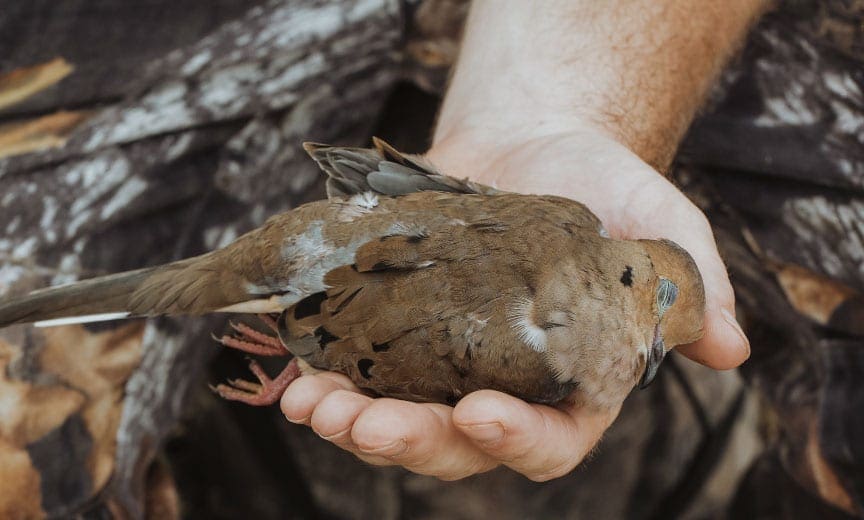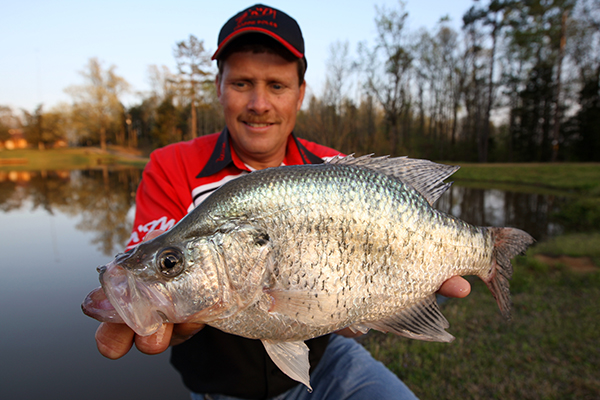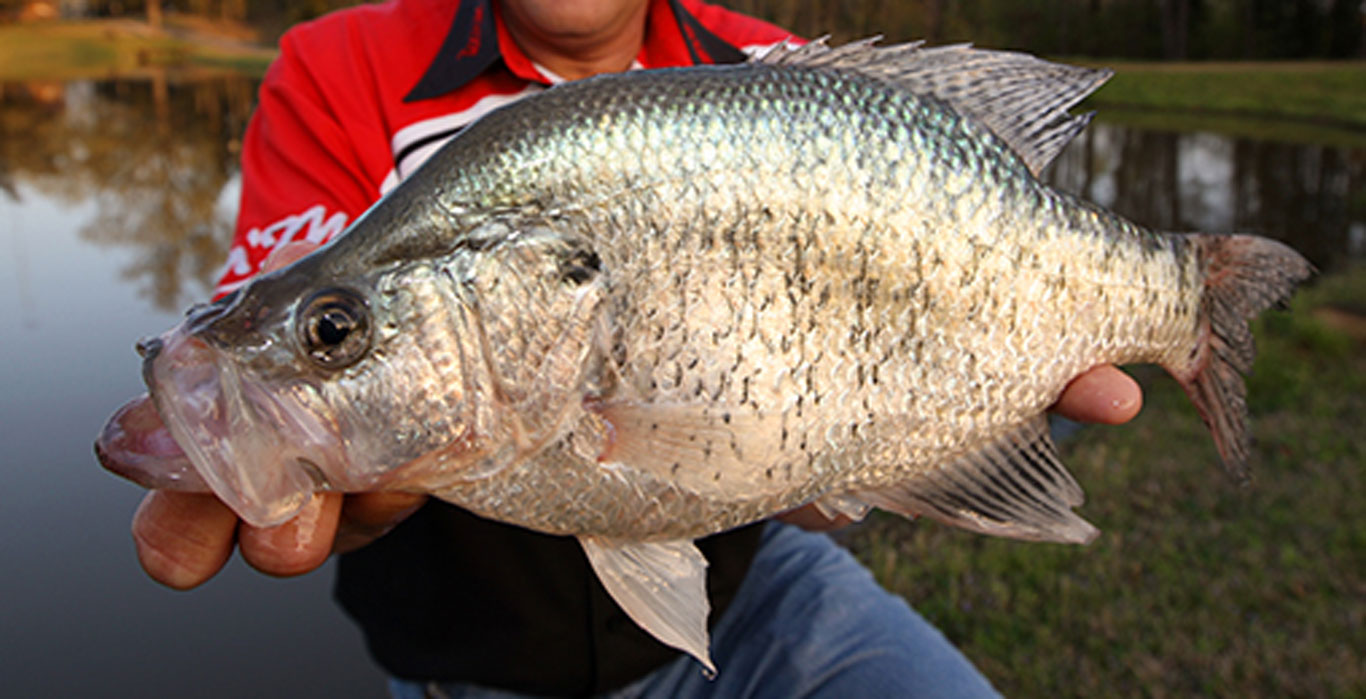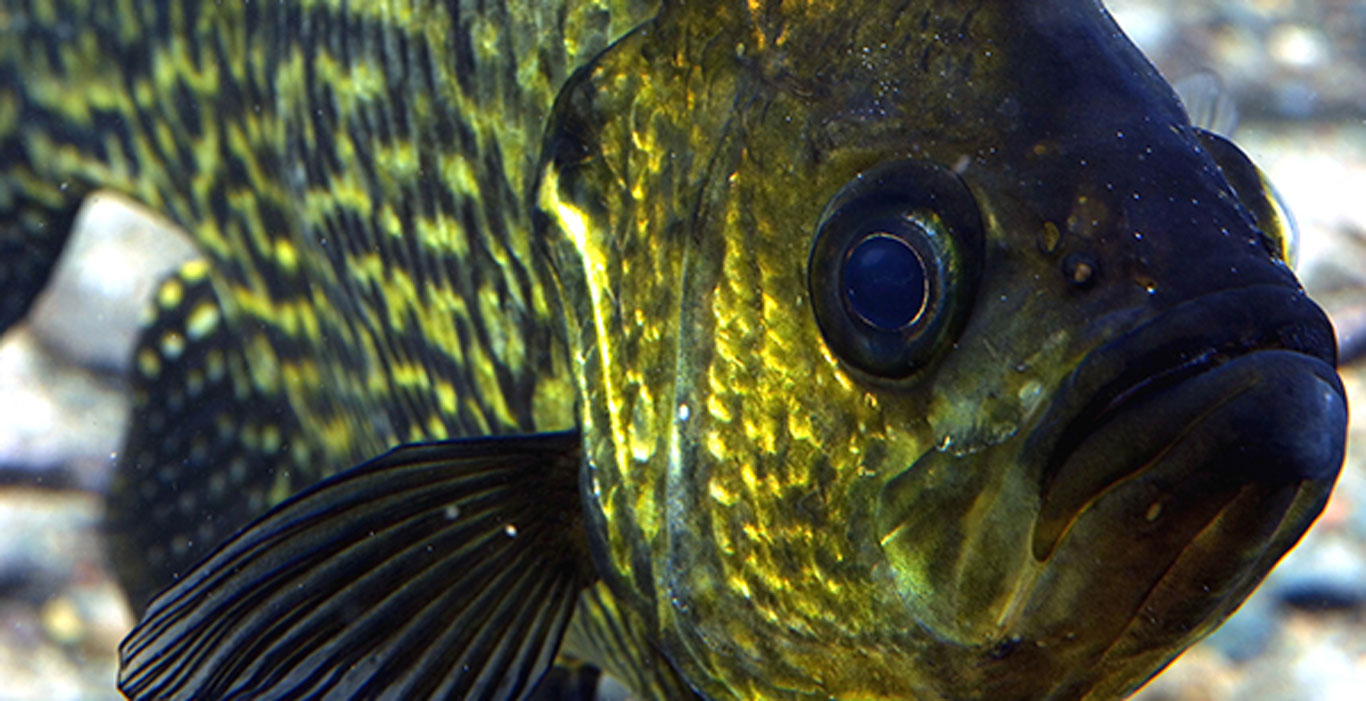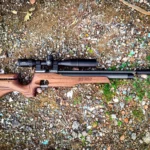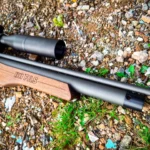Thermal scopes are perfect for low-light shooting, giving any hunter an advantage in the field.
An excellent thermal sight will let you see targets not possible with your bare eyes.
What to Look for In a Thermal Scope
There are a few things to consider when buying a thermal scope to ensure you get the best one for you.
Resolution
Much like your flat-screen television, thermal scopes have a resolution, which significantly affects image quality.
Thermal scopes have two resolutions to consider: the display resolution and the sensor resolution.
To put it simply, a sensor resolution is a resolution you will get while using thermal imaging, and the display resolution will be your standard view.
So, if you have a 160 x 120 pixel sensor and a 1280 x 720 display, your targets will only come in 160 x 120 while using thermal.
Battery Life
Some scopes are energy hogs and will drain your battery quickly.
However, several models on this list will last over 10 hours of continuous use between charges.
Features
Many features come with thermal scopes, including smart features, various magnifications, video recording, and range finding.
Make sure you pick the features that are important to you.
Below are the 12 best thermal scopes on the market.
#1. ATN ThOR LT 3-6x50mm Thermal Rifle Scope
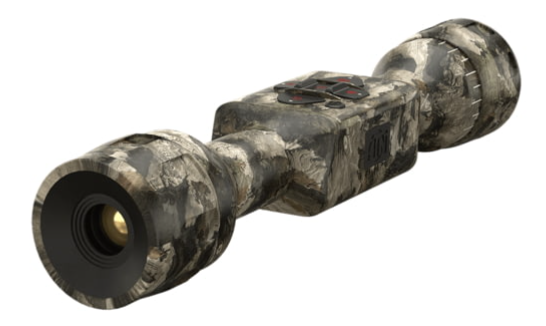
- Magnification: 3x – 6x
- Sensor Resolution: 160 x 120 Pixels
- Battery Life: 10+ Hours
- Waterproof: Weather Resistant
- Magnification Type: Variable
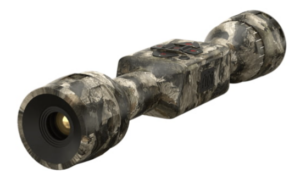
The ATN ThOR LT 3-6x50mm Thermal Rifle Scope is a variable 3x – 6x magnified thermal scope perfect for nighttime hunting.
It has a 30mm tube and a 50mm for excellent visibility.
With the latest thermal technology, it has a display resolution of 1280 x 720 pixels with a 160 x 120 pixels sensor resolution.
They made it to withstand the elements with a weather-resistant IP rating and a lightweight, durable aluminum body.
You can use it for 10+ continuous hours, and it comes with White Hot and Black Hot Color modes.
Other features include multiple reticle patterns, a 3D accelerometer, and a one-shot zero.
If you are looking for a solid thermal scope with excellent battery life, the ATN ThOR LT 3-6x50mm Thermal Rifle Scope is perfect for crossbows, rifles, and other weapon systems.
It is available from Optics Planet. Here’s where to buy it: www.OpticsPlanet.com
#2. Pulsar Core RXQ30V 1.6-6.4x22mm Thermal Imaging Rifle Scope
- Magnification: 6x, 2x – 4x Digital Zoom
- Sensor Resolution: 384 x 288 pixels
- Battery Life: 4 Hours
- Waterproof: Yes
- Magnification Type: Variable

Pulsar’s Core RXQ30V 1.6-6.4x22mm Thermal Imaging Rifle Scope is an excellent thermal option for close-range hunts.
It has a 22mm objective lens, a 640 x 480 pixel display, a 384 x 288 thermal sensor with 985 yards of detection, and a 50Hz refresh rate for excellent visibility.
The Pulsar RXQ30V comes with a green sapphire display mode, white-hot mode, and black hot mode.
The scope can easily attach to the most popular models of rifles and crossbows with a Weaver/Picatinny mount.
They constructed the scope out of heavy-duty glass-nylon composite and can be operated in extreme temperatures (-13 degrees to 122 degrees Fahrenheit).
It comes with 2x CR123A batteries, and a single charge can last up to 4 hours.
The Pulsar Core RXQ30V 1.6-6.4x22mm Thermal Imaging Rifle Scope is an excellent addition to any weapon.
It is available from Optics Planet. Here’s where to buy it: www.OpticsPlanet.com
#3. Burris BTS 50 3.3-13.2x50mm Thermal Rifle Scope
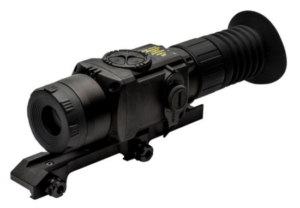
- Magnification: 3x – 13.2x
- Sensor Resolution: 400×300 Pixels
- Battery Life: 5 Hours
- Waterproof: Not Specified
- Magnification Type: Variable

The Burris BTS 50 3.3-13.2x50mm Thermal Rifle Scope has unique features that set it apart from its competition.
It has a high-resolution 400 x 300 pixel screen with several customization options to match your tastes.
The scope provides seven different color palettes and ten reticle options to form the best combination for you.
An excellent feature is the heat tracking utility where it will highlight the area with the most heat for faster target acquisition.
The battery can last up to 5 hours of continuous use, and the scope comes with multiple thermal options.
It also includes integrated stadiametric rangefinding for accurate shooting at unknown distances.
If you are looking for a thermal scope with plenty of viewing options and a high-resolution screen, the Burris BTS 50 3.3-13.2x50mm Thermal Rifle Scope may be right for you.
It is available from Optics Planet. Here’s where to buy it: www.OpticsPlanet.com
#4. Accufire Technology Incendis Clip-On 1 – 4x 30mm Thermal Imaging Rifle Scopes

- Magnification: 1x – 4x
- Sensor Resolution: 384 x 288 Pixels
- Battery Life: 4 Hours
- Waterproof: Not Specified
- Magnification Type: Variable

The Accufire Technology Incendis Clip-On 1 – 4x 30mm Thermal Imaging Rifle Scopes has a super intuitive double reticle and can be used as a standalone scope, standalone monocular, or an attachment for your favorite optic.
It has four heat displays to choose from: White-Hot, Black-Hot, Red Accent, and Green-Hot.
It has a variable magnification of up to 4x and has a display resolution of 1024 × 768 pixels, a core resolution of 384 x 288 pixels, and a 60Hz refresh rate for a sharp image.
The Incendis can operate in harsh environments with an operating temperature range of -22 degrees to 122 degrees Fahrenheit.
If you want to upgrade your current scopes capabilities, the Accufire Technology Incendis Clip-On 1 – 4x 30mm Thermal Imaging Rifle Scope is perfect for you.
It is available from Optics Planet. Here’s where to buy it: www.OpticsPlanet.com
#5. Pulsar Thermion XM50 5.5-22x42mm Thermal Rifle Scope
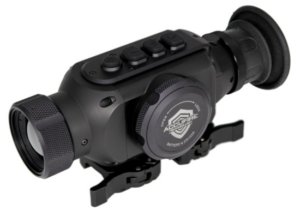
- Magnification: 5x – 22x
- Sensor Resolution: 320 x 240 Pixels
- Battery Life: 5+ Hours
- Waterproof: Yes
- Magnification Type: Variable

The Pulsar Thermion XM50 5.5-22x42mm Thermal Rifle Scope is a second focal plane variable scope with a 5.5x to 22x magnification.
The XM50 has some impressive features that make it one of the best thermal scopes on the list, but it is expensive.
You will clearly see your target in any lighting conditions with a maximum heat range of 2,500 yards.
It has an impressive 1024 x 768 pixel display resolution and a 340 x 240 sensor resolution.
One of the remarkable features of this scope is the built-in recording with recoil activation.
You can capture or live-stream your most intense hunts in 1024 x 768 resolution.
Another pleasant feature is that you can store up to five different rifle profiles into the scope for easy swapping between your weapon sets.
With an integrated rangefinder, you will have pinpoint shooting at any distance.
It also has a lifetime warranty.
The Pulsar Thermion XM50 5.5-22x42mm Thermal Rifle Scope is an excellent buy if you have the money.
It is available from Optics Planet. Here’s where to buy it: www.OpticsPlanet.com
#6. ATN ThOR LT 4-8x50mm Thermal Rifle Scope

- Magnification: 4x – 8x
- Sensor Resolution: 160 x 120 Pixels
- Battery Life: 10 Hours
- Waterproof: Weather Resistant
- Magnification Type: Variable

The ATN ThOR LT 4-8x50mm Thermal Rifle Scope has a 160 x 120 sensor resolution, a 1280 x 720 pixel display, and a 60 Hz refresh rate.
You will be able to clearly see your target with up to 8x magnification.
It has an impressive battery life with up to 10 hours of continual on a single charge to last you your entire hunt.
They had this thermal scope with a hardened aluminum body resistant to the harshest weather.
Other features include multiple reticle patterns, a white-hot mode, a black-hot mode, and a 3D accelerometer.
If you are looking for a balance between value and features, the ATN ThOR LT 4-8x50mm Thermal Rifle Scope will not let you down.
It is available from Optics Planet. Here’s where to buy it: www.OpticsPlanet.com
#7. Sig Sauer ECHO3 1-6x23mm Thermal Reflex Sight
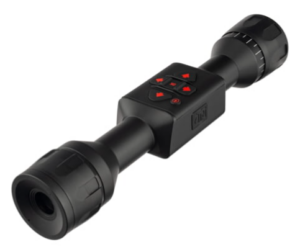
- Magnification: 1x – 6x
- Sensor Resolution: 320 x 240 Pixels
- Battery Life: 6 Hours
- Waterproof: Yes
- Magnification Type: Variable

The Sig Sauer ECHO3 1-6x23mm Thermal Reflex Sight is an excellent thermal sight for predators and hog hunters.
It has a high-resolution sensor core with 320 x 240 pixel resolution and a 30 Hz refresh rate.
You can connect it to any BDX smart device via Wi-Fi or Bluetooth to capture images or recordings of your hunt.
The recorder is recoil activated, and the display has eleven color pallets and several brightness levels.
It also has a MOTAC (Motion Activated Display), which activates on motion to save battery life, but the sight can last over six hours of heavy use on a single charge.
If you want a reflex sight style thermal scope perfect for hog hunting, buy the Sig Sauer ECHO3 1-6x23mm Thermal Reflex Sight today.
It is available from Optics Planet. Here’s where to buy it: www.OpticsPlanet.com
#8. ATN OPMOD Exclusive ThOR LT 4-8x50mm Thermal Rifle Scope
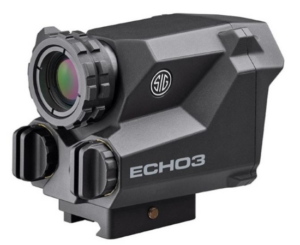
- Magnification: 4x – 8x
- Sensor Resolution: 160 x 120 Pixels
- Battery Life: 10 Hours
- Waterproof: Weather Resistant
- Magnification Type: Variable

The ATN OPMOD Exclusive ThOR LT 4-8x50mm Thermal Rifle Scope is like the standard version, but with an exclusive Optics Planet modification.
It has a variable 4x to 8x magnification with a 160 x 120 pixel resolution.
It also has a battery that will last up to ten hours.
The modified version has a custom hog hunting reticle, and a quick detach mount, which is exclusive to this version.
If you liked the original, but want a custom reticle designed for hog hunting, the OPMOD Exclusive is an excellent choice for you.
It is available from Optics Planet. Here’s where to buy it: www.OpticsPlanet.com
#9. AGM Global Vision Rattler TS25-384 1.5x25mm Compact Thermal Imaging Rifle Scope

- Magnification: 5x, 8x Digital Zoom
- Sensor Resolution: 384 x 288 Pixels
- Battery Life: 5 Hours
- Waterproof: Yes
- Magnification Type: Fixed

The AGM Global Vision Rattler TS25-384 1.5x25mm Compact Thermal Imaging Rifle Scope is a compact thermal scope perfect for medium-range hunts.
The sensor core resolution is 384 x 288 pixels and a 1024 x 768 OLED display with a 50 Hz refresh rate, making it easy to see in any weather, including fog, rain, or smoke.
They made it to withstand harsh weather with an IP67 water resistance level and an operating temperature of -4 degrees to 131 degrees Fahrenheit.
It has a 4.5-hour battery life, but you could extend it via a USB 5V power bank.
An excellent feature is that you can easily stream or record your hunts via Wi-Fi.
It also includes a limited three-year warranty.
The AGM Global Vision Rattler TS25-384 1.5x25mm Compact Thermal Imaging Rifle Scope is perfect for anyone who wants a durable thermal scope that can record video at a medium range.
It is available from Optics Planet. Here’s where to buy it: www.OpticsPlanet.com
#10. Pulsar Trail 2 LRF XP50 Thermal Rifle Scope
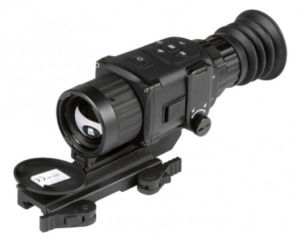
- Magnification: 2x – 16x
- Sensor Resolution: 640 x 480 Pixels
- Battery Life: 8 Hours
- Waterproof: Yes
- Magnification Type: Variable

Pulsar’s Trail 2 LRF XP50 Thermal Rifle Scope has the highest sensor resolution on the list with an impressive 640 x 480 pixel resolution for excellent image quality.
It also has a 1024 x 768 pixel resolution display with several modes, reticle options, and illumination color options.
They built this scope to last with a lightweight glass-nylon composite housing and an IPX-7 waterproof rating.
With a built-in rangefinder with a maximum range of 1,100 yards, you will get accurate shots at any distance.
It has a 16 Gb internal storage to record your hunts and comes with built-in Wi-Fi to access your app to record or stream your hunt.
The Pulsar Trail 2 LRF XP50 Thermal Rifle Scope is the best thermal scope on this list, but it is also the most expensive.
It is available from Optics Planet. Here’s where to buy it: www.OpticsPlanet.com
#11. ATN ThOR 4 1.25-5x19mm Thermal Smart HD Rifle Scope
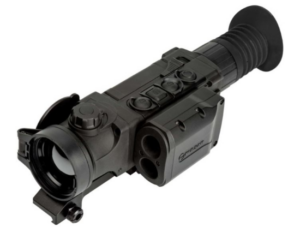
- Magnification: 25x – 5x
- Sensor Resolution: 384 x 288 Pixels
- Battery Life: 18 Hours
- Waterproof: Weather Resistant
- Magnification Type: Variable

The ATN ThOR 4 1.25-5x19mm Thermal Smart HD Rifle Scope has smart features that the other ATM ThORs lack.
It includes smart features such as Wi-Fi, Bluetooth 4.1, GPS, iOS/Android apps, recoil activated recording, and a MicroSD card slot for recording.
Other features include a built-in rangefinder, 3D GS7 Gyroscope, 3D Accelerometer, 3D Magnetometer, and an E-Compass.
With a massive 18-hour battery life, you can hunt all day without needing to worry about your battery life.
It also includes a three-year limited warranty.
If you want a solid thermal scope with smart features, the ATN ThOR 4 1.25-5x19mm Thermal Smart HD Rifle Scope is an excellent choice.
It is available from Optics Planet. Here’s where to buy it: www.OpticsPlanet.com
#12. ATN ThOR LT 320 3-6x30mm Thermal Rifle Scope
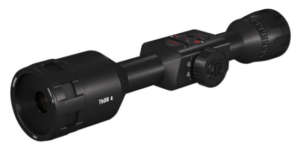
- Magnification: 3x – 6x
- Sensor Resolution: 320 x 240 Pixels
- Battery Life: 10+ Hours
- Waterproof: Weather Resistant
- Magnification Type: Variable

The ATN ThOR LT 320 3-6x30mm Thermal Rifle Scope has an internal rechargeable battery that lasts up to 10+ hours on a single charge, saving you money on batteries.
They made it to last in any environment with a weather-resistant design and an aluminum body.
It has a 3x to 6x variable magnification with a display resolution of 1280 x 720 pixels and a sensor resolution of 320 x 240 pixels at 60 Hz.
It has a simple design, making thermal imaging easy to use for fast target acquisition.
If you are looking for a rechargeable thermal scope, the ATN ThOR LT 320 3-6x30mm Thermal Rifle Scope is an excellent choice.
It is available from Optics Planet. Here’s where to buy it: www.OpticsPlanet.com
References / Resources
How To Choose A Thermal Rifle Scope
Night Vision vs. Thermal Scopes
How To Sight In A Thermal Scope
See Also
Best Spotting Scopes For Hunting & Target Shooting
Best Air Rifle & Pistol Scopes
Best Laser Sights For Pistols
Best Night Vision Goggles & Binoculars
Best Rangefinders For Hunting & Golf
Affiliate Disclosure: This post may contain affiliate links. If you click and purchase, I may receive a small commission at no extra cost to you. I only recommend products I have personally vetted. Learn more.











![Air gun 101: The differences between .177 & .22 – Which jobs they do best ? [Infographic]](https://airgunmaniac.b-cdn.net/wp-content/uploads/2024/11/1773-218x150.jpeg)








































